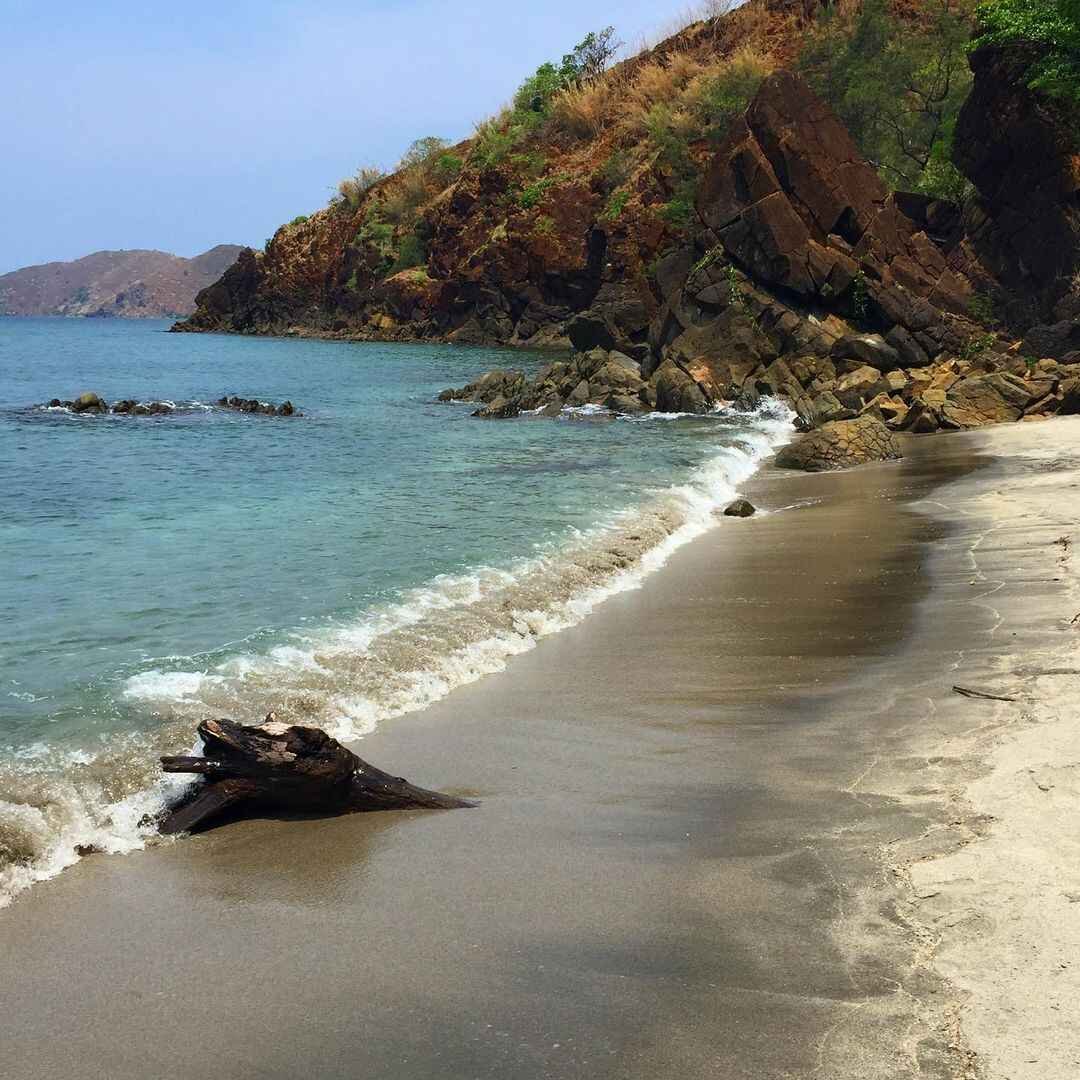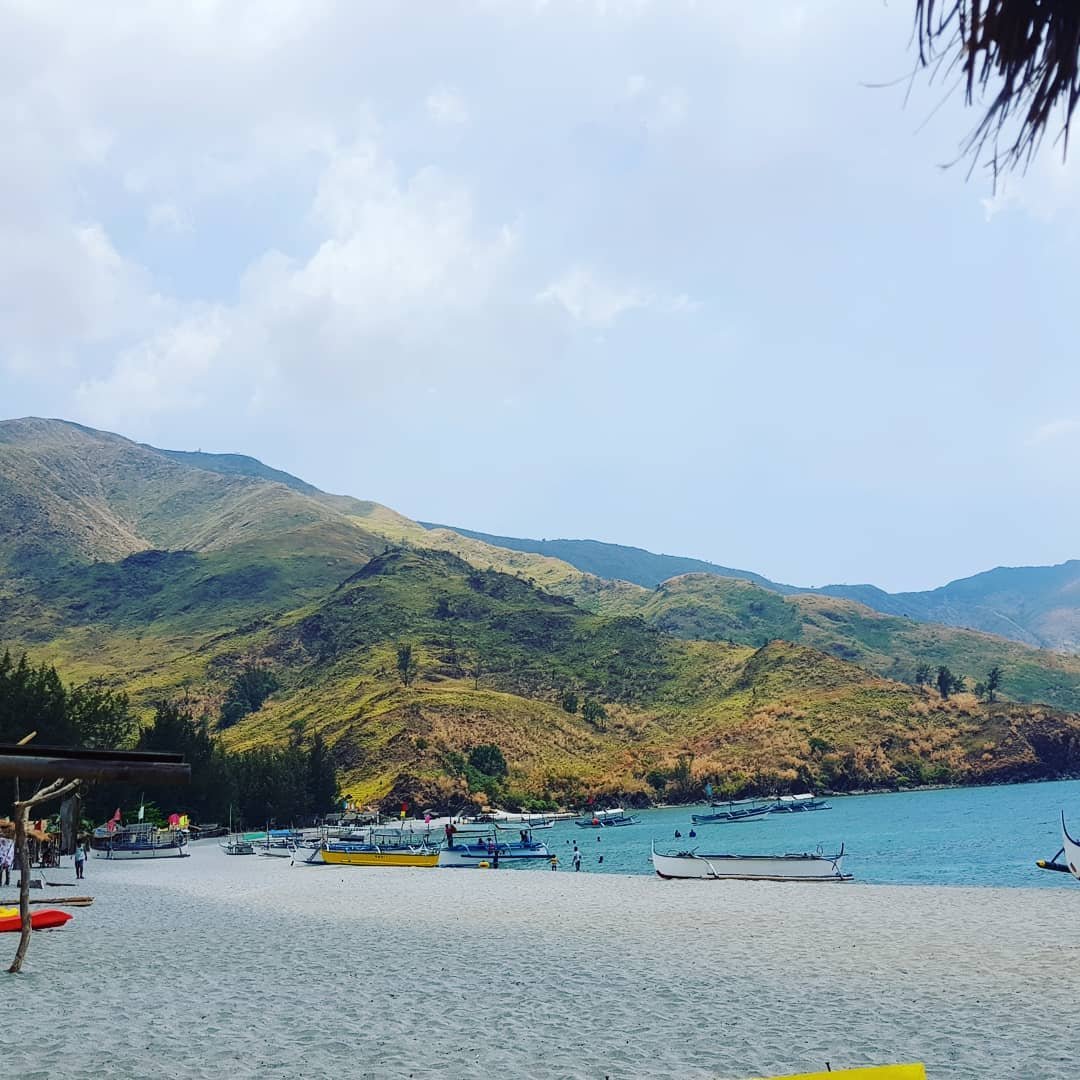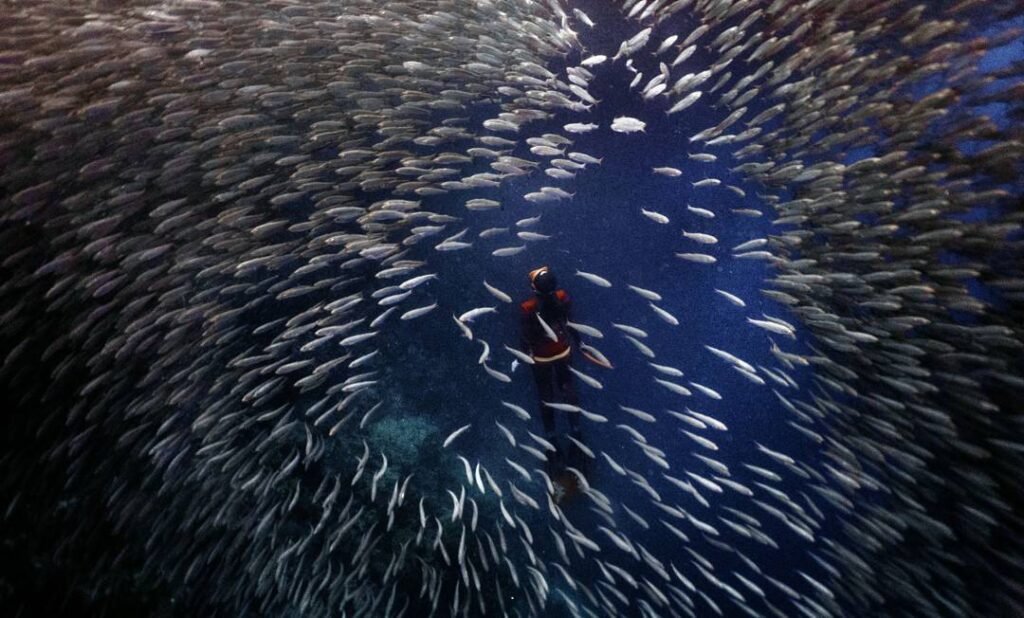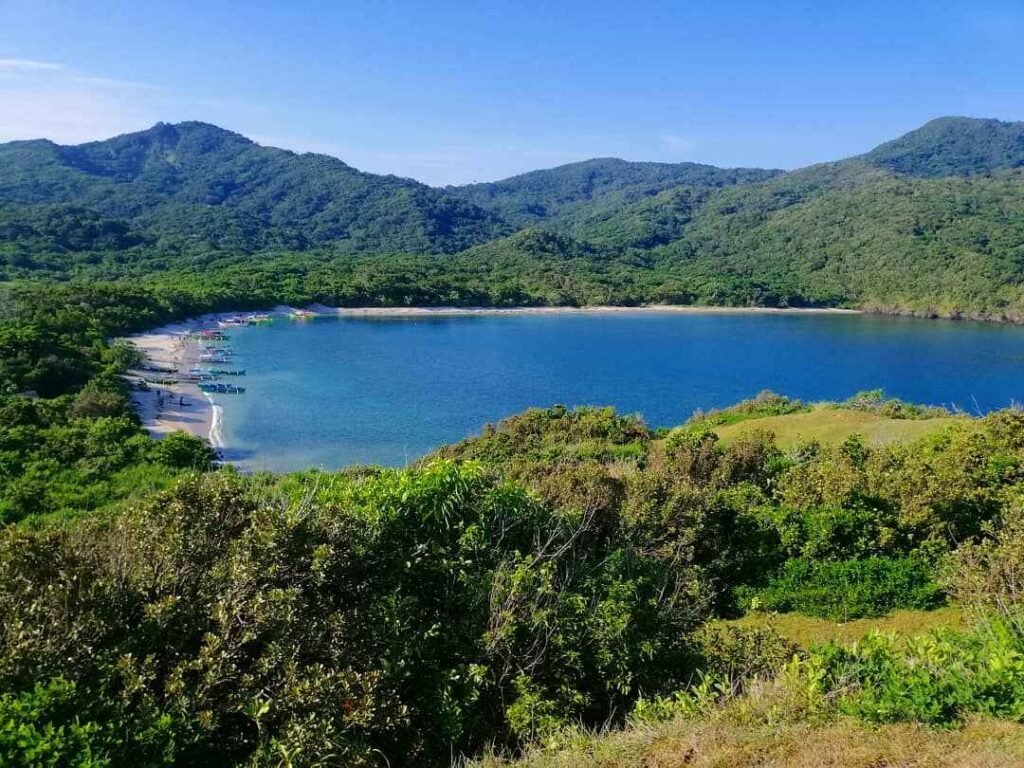
When I first heard about Nagsasa Cove, I knew it was a destination I had to visit. Nestled in the province of Zambales, this hidden paradise offers an ideal blend of adventure, relaxation, and natural beauty. The cove, formed after the Mt. Pinatubo eruption in 1991, is known for its stunning volcanic ash beaches, tranquil waters, and lush forests of Agoho trees (mistaken for pine trees). These unique features make Nagsasa stand out from other destinations like Anawangin Cove.
For anyone seeking an escape from the crowds and the fast-paced city life, Nagsasa Cove Zambales 2024 is the perfect retreat. Unlike its more popular neighbor, Anawangin, Nagsasa offers a more secluded and peaceful atmosphere, making it the perfect destination for nature lovers and adventure seekers.
Whether you enjoy camping, hiking, or simply lounging on the beach, Nagsasa Cove provides a wide range of activities for all kinds of travelers. For the more adventurous, hiking up the surrounding hills rewards you with breathtaking views of the entire cove. At night, the lack of light pollution makes it a perfect spot for stargazing and relaxing by a bonfire.
Reaching Nagsasa Cove is part of the adventure itself. The journey from Manila involves a scenic boat ride from Pundaquit Beach, offering views of nearby coves and cliffs, which enhances the experience before you even set foot on the beach.
If you’re planning to visit in 2024, now is the perfect time to explore this lesser-known gem. From a DIY budget trip to organized tour packages, Nagsasa Cove has something for everyone.
Zambales Travel Guide and 23 Must-Visit Tourist Spot in Zamables
Table of Contents
Nagsasa Cove vs. Anawangin: Which One to Visit?
When choosing between Nagsasa Cove and Anawangin Cove, both located in San Antonio, Zambales, it’s important to understand their similarities and differences to determine which destination suits your preferences. Both coves are products of the 1991 Mt. Pinatubo eruption, which transformed the landscape with volcanic ash deposits, creating dramatic beachscapes bordered by Agoho trees (often mistaken for pine trees). However, each offers a distinct experience.
Crowd and Atmosphere
-
Nagsasa Cove: Known for its peaceful and laid-back vibe, Nagsasa Cove is less crowded compared to Anawangin. The larger cove provides more space for visitors to spread out, making it a better option for those who want to avoid the hustle and bustle of busy beaches. It’s ideal for campers who prefer solitude, and it has a more remote, secluded feel.
-
Anawangin Cove: As the more popular and accessible destination, Anawangin Cove attracts larger crowds, especially on weekends and holidays. If you enjoy socializing with fellow travelers and don’t mind a more lively atmosphere, Anawangin might be for you. However, its popularity can sometimes lead to overcrowding, which detracts from the tranquil beach experience that many seek in Zambales.
Accessibility
-
Nagsasa Cove: Because it’s farther from the mainland, Nagsasa Cove requires a longer boat ride (around 45 minutes to 1 hour from Pundaquit Beach), making it slightly more challenging to reach. This additional travel time contributes to its more serene environment, as fewer tourists make the journey.
-
Anawangin Cove: Located closer to Pundaquit, Anawangin Cove is more easily accessible, with a boat ride that takes only about 20-30 minutes. For day-trippers and those with limited time, Anawangin is often the more convenient choice.
Scenery and Activities
-
Nagsasa Cove: With its wider beach and more open space, Nagsasa Cove provides a scenic backdrop of mountains and Agoho trees. The cove offers more space for camping and exploring. You can hike the surrounding hills for panoramic views or visit Nagsasa Cove Lake, a peaceful lagoon just behind the beach. The cove is perfect for those who enjoy longer stays, trekking, and more personal space to enjoy nature.
-
Anawangin Cove: While Anawangin also offers hiking opportunities, particularly to the nearby hills, its smaller size and higher volume of visitors can make the experience feel more crowded. It’s still a picturesque spot with calm waters and the characteristic Agoho trees lining the shore, but it lacks the expansive feel of Nagsasa.
Camping Experience
-
Nagsasa Cove: If you’re a fan of camping, Nagsasa Cove offers a more peaceful and private experience. The campsite is larger, allowing visitors to pitch tents away from others for more privacy. Bonfires, stargazing, and quiet evenings by the beach are typical highlights here.
-
Anawangin Cove: Camping at Anawangin Cove tends to be more communal, with tents often set up closer together due to the limited space. While this can foster a more social environment, it may not be ideal if you’re looking for peace and quiet.
Cost
-
Nagsasa Cove: Due to the longer boat ride, visiting Nagsasa Cove can be slightly more expensive than Anawangin. The cost of boat rentals to Nagsasa Cove typically ranges from PHP 2,000-2,500 for a round trip, while boat rides to Anawangin are generally around PHP 1,500-2,000.
-
Anawangin Cove: As the closer and more popular destination, Anawangin Cove is slightly cheaper and easier to include in day trips. Many island-hopping tours also feature Anawangin as a stop, which can reduce costs if you’re visiting multiple coves in one go.
How to Go to Nagsasa Cove from Manila
Getting to Nagsasa Cove from Manila is part of the adventure and requires multiple modes of transportation. While the journey might seem complex, this step-by-step guide ensures you can travel smoothly. Here’s an expanded guide with more details, optimized for travelers interested in both DIY trips and tour packages.
Step 1: Bus from Manila to San Antonio, Zambales
The first leg of your journey starts with a bus ride from Manila to San Antonio, Zambales. Here’s a breakdown of the steps:
-
Bus Terminals: Buses bound for Zambales depart from various terminals in Manila, including Victory Liner in Cubao, Pasay, or Caloocan. Victory Liner is one of the most reliable bus companies serving this route.
-
Bus Route and Schedule: You need to board a bus going to Iba or Sta. Cruz, Zambales. Make sure to inform the driver that your destination is San Antonio so you can get off at the right stop. These buses usually operate regularly, but it’s best to take an early morning bus to maximize your time at Nagsasa Cove.
-
Travel Time: The bus ride from Manila to San Antonio takes approximately 3-4 hours, depending on traffic.
-
Fare: Expect to pay around PHP 300-400 for a one-way ticket.
Step 2: Tricycle to Pundaquit Beach
Once you arrive at San Antonio, the next part of your journey involves a tricycle ride to Pundaquit Beach, which is the jump-off point for boats heading to Nagsasa Cove.
-
Tricycle Station: Tricycles are readily available near the bus stop in San Antonio, usually around the town’s public market or near the Municipal Hall.
-
Fare and Travel Time: The tricycle ride costs around PHP 100-150 and takes about 15-20 minutes to reach Pundaquit Beach.
-
Tip: It’s a good idea to have small bills ready for payment, as tricycle drivers may not always have change.
Step 3: Boat Ride to Nagsasa Cove
From Pundaquit Beach, the final leg of your trip is a scenic boat ride to Nagsasa Cove. The boat ride offers stunning coastal views and is often one of the highlights of the journey.
-
Boat Rental: You’ll need to hire a boat to take you to Nagsasa Cove. Boats can be rented for around PHP 2,000-2,500 for a round trip, and they usually accommodate up to 4-5 people. The cost can be split among your group to save on expenses.
-
Boat Ride Duration: The boat ride takes about 45 minutes to 1 hour, depending on sea conditions.
-
Tips:
- Negotiate: Always negotiate the boat rental price, especially if you’re traveling during the off-season.
- Confirm Return Time: Make sure to arrange with your boatman for a pick-up time when you’re ready to head back to Pundaquit.

Nagsasa Cove Activities
Things to do in Nagsasa Cove, a hidden gem in Zambales, offers a wide range of activities for both adventurers and those looking to relax in a pristine environment. Whether you prefer swimming in clear waters, hiking scenic trails, or simply lounging on the beach, there’s something for everyone. Here’s an in-depth look at the activities you can enjoy during your visit to Nagsasa Cove:
1. Swimming and Beach Lounging
The clear and calm waters of Nagsasa Cove are perfect for swimming. Unlike some more popular beaches, Nagsasa remains less crowded, giving you ample space to enjoy the water. The cove’s gentle waves make it safe for both beginners and families with children. After a swim, you can lounge on the soft, volcanic-ash beach, which stretches out along the cove, offering plenty of room to relax and soak up the sun.
2. Camping
Camping is one of the main reasons visitors flock to Nagsasa Cove. The serene, natural setting makes it an ideal place to pitch a tent and enjoy the outdoors. There are designated camping areas along the beach, where you can set up your gear. Many visitors bring their own camping supplies, but if you don’t, tents and other equipment can be rented on-site for around PHP 300-500 per night.
Camping in Nagsasa Cove allows you to fully immerse yourself in the natural environment. At night, you can sit around a bonfire, roast marshmallows, and share stories with fellow campers. Since there’s little light pollution, stargazing is an absolute must—on a clear night, you can see thousands of stars twinkling in the sky.
3. Hiking
If you’re an outdoor enthusiast, hiking in and around Nagsasa Cove is a fantastic way to enjoy its scenic beauty. One of the most popular hikes is the trail that leads to the viewpoint overlooking the cove. This moderate trek takes about 30-45 minutes and rewards you with a breathtaking panoramic view of the beach, surrounding mountains, and the vast sea.
For those seeking more adventure, there are longer hikes to the hills and mountains surrounding Nagsasa Cove, including treks to nearby waterfalls. These hikes provide a unique opportunity to see more of the cove’s natural landscape and are suitable for both novice and experienced hikers.
4. Snorkeling and Fishing
Snorkeling is a fun way to explore the underwater life of Nagsasa Cove. While the cove doesn’t boast vibrant coral reefs like other popular snorkeling destinations in the Philippines, it still has some interesting marine life to observe. Bring your own snorkeling gear, as rentals might not always be available on-site.
Additionally, fishing is a popular activity among locals and tourists. You can either fish directly from the shore or arrange a fishing trip with local guides who will take you to the best spots around the cove.
5. Island Hopping
Island hopping is one of the highlights of visiting Nagsasa Cove. From Pundaquit Beach or Nagsasa Cove, you can arrange a boat tour to explore nearby islands and coves such as Anawangin Cove, Capones Island, Camara Island, and Talisayin Cove. These spots offer different landscapes and activities, from trekking to swimming and snorkeling.
Island hopping tours typically cost around PHP 3,500-4,000 for a group of up to 4-5 people, making it a cost-effective option if you’re traveling with friends or family.

Sample Nagsasa Cove 2 Days Itinerary
Here’s a suggested 2-day itinerary to make the most of your time at Nagsasa Cove:
Day 1:
- 4:00 AM: Leave Manila and take the bus to San Antonio, Zambales.
- 8:00 AM: Arrive in San Antonio, take a tricycle to Pundaquit Beach, then rent a boat to Nagsasa Cove.
- 9:30 AM: Arrive at Nagsasa Cove, set up camp or check into your accommodation.
- 10:30 AM: Explore the beach, swim, or relax by the shore.
- 12:00 PM: Enjoy a picnic lunch by the beach.
- 2:00 PM: Hike up the hill for panoramic views of the cove.
- 6:00 PM: Enjoy a beachside bonfire and stargazing.
Day 2:
- 5:30 AM: Watch the sunrise from the beach or hike to the nearby viewpoint.
- 7:00 AM: Breakfast, followed by some swimming or exploring Nagsasa Cove Lake.
- 11:00 AM: Pack up and take the boat back to Pundaquit.
- 1:00 PM: Head back to San Antonio and board the bus back to Manila.
Nagsasa Cove DIY Budget Travel Guide
Planning a DIY trip to Nagsasa Cove is one of the most cost-effective ways to experience this stunning destination in Zambales. With its raw beauty and serene ambiance, it’s a great destination for nature lovers and adventurers alike. Here’s a comprehensive guide to help you plan a budget-friendly DIY trip to Nagsasa Cove, along with a comparison to the available tour packages.
Transportation Costs
- Bus Fare (Manila to San Antonio, Zambales):
- From Manila, you’ll need to take a bus bound for Iba or Sta. Cruz, Zambales. Buses depart from terminals like Victory Liner in Cubao, Pasay, or Caloocan. The one-way fare is around PHP 300-400, depending on the bus company and class.
- Travel time: Approximately 3-4 hours.
- Tricycle Fare (San Antonio to Pundaquit Beach):
- Once you arrive at San Antonio, you’ll need to take a tricycle to Pundaquit Beach, which costs PHP 100-150 per ride (good for 2-3 people). The tricycle ride takes about 15-20 minutes.
- Boat Ride to Nagsasa Cove:
- From Pundaquit, hire a boat to Nagsasa Cove. Boat rentals typically cost around PHP 2,000-2,500 for a round trip, accommodating up to 4-5 people. The boat ride takes approximately 45 minutes.
- Pro Tip: You can save money by sharing the boat with other groups if you’re traveling solo or as a couple.
Accommodation Costs
- Camping Fee: If you’re bringing your own tent, the entrance and camping fee is usually around PHP 100-150 per person per night.
- Tent Rental: If you don’t have your own tent, you can rent one on-site for about PHP 300-500 per night.
Food and Supplies
Since Nagsasa Cove is remote, it’s recommended to bring your own food and water. There are small stores at the cove, but the prices are higher and the selection is limited.
- Food Supplies: Expect to spend around PHP 500-1,000 for food and drinking water for a 2-day trip. You can buy supplies at the San Antonio public market before heading to the cove. Bringing your own meals (especially easy-to-cook or ready-made food) is much more cost-effective than buying from local vendors at the cove.
Sample Budget for a 2-Day DIY Trip:
For a group of 4, here’s an estimate of total expenses per person:
- Bus Fare (round trip): PHP 600-800
- Tricycle Fare (round trip): PHP 50-75
- Boat Rental (shared among 4 people): PHP 500-625
- Camping Fee: PHP 100-150
- Food and Supplies: PHP 500-1,000
Total estimated cost per person for 2 days: PHP 1,500-2,500.

Best Time to Visit Nagsasa Cove
The best time to visit Nagsasa Cove is during the dry season, from November to May, when the weather is sunny and perfect for camping, hiking, and swimming. Avoid the rainy season (June to October), as boat rides may be canceled due to rough seas.
Nagsasa Cove Resorts and Accommodations
While Nagsasa Cove is primarily known as a camping destination, there are a few accommodation options for those who prefer a bit more comfort than roughing it out in a tent. Most of these accommodations remain simple and rustic, blending well with the natural surroundings of the cove. However, the nearby areas like Pundaquit also offer more comfortable options, including beach resorts, for travelers who want a more relaxed stay before or after visiting Nagsasa Cove.
Here’s an overview of the types of accommodations available both at the cove and nearby:
1. Camping in Nagsasa Cove
Camping is the most popular and affordable accommodation option at Nagsasa Cove. With its tranquil setting, camping allows visitors to fully immerse themselves in the natural beauty of the cove. There are several designated camping areas along the beach, where visitors can set up tents, build bonfires, and enjoy stargazing at night.
- Cost: Camping fees typically range from PHP 100-150 per person per night.
- Tent Rental: If you don’t have your own tent, you can rent one from locals at the cove. Tent rentals cost around PHP 300-500 per night, depending on the size of the tent.
Facilities:
- Basic Amenities: Most campsites offer basic amenities, such as access to simple toilets and freshwater for washing.
- Power: There’s no permanent electricity in the cove, so it’s advisable to bring power banks, flashlights, and other essentials.
- 2. Nipa Huts and Simple Cottages
For travelers who prefer more shelter than a tent, nipa huts or simple cottages are available for rent. These basic accommodations offer a roof over your head, providing more comfort without straying far from the rustic, natural experience.
- Cost: Rates for nipa huts or cottages range from PHP 500-1,500 per night, depending on the size and amenities provided. Most of these huts are equipped with a simple bed, but don’t expect luxury here; the huts blend with the natural surroundings.
Facilities:
- Basic Shelters: These cottages are usually made of bamboo and other natural materials, designed to keep you close to nature while providing more comfort than a tent.
- Simple Bedding: While some huts may provide basic bedding, others might require you to bring your own sleeping bags or blankets.
3. Resorts Near Pundaquit Beach
If you’re looking for more comfortable accommodations with modern amenities, you’ll need to stay near Pundaquit Beach—the jump-off point for boat trips to Nagsasa Cove. Pundaquit has several small beach resorts offering more convenience, such as electricity, air conditioning, and private bathrooms.
Here are some popular resorts near Pundaquit Beach:
- Rates: PHP 2,500-3,500 per night.
- Amenities: Air-conditioned rooms, private bathrooms, swimming pool, and beachfront access.
- Rates: PHP 1,500-2,500 per night.
- Amenities: Basic rooms with fan or air conditioning, beachfront cottages, and nearby boat rentals for island hopping.
Monty’s Riverside View Resort:
- Rates: PHP 1,800-2,500 per night.
- Amenities: Simple rooms with air conditioning, a restaurant, and access to river and beach areas.
4. Homestays in San Antonio
For travelers looking to stay inland before or after their trip to Nagsasa Cove, homestays and budget inns are available in San Antonio, the nearest town. These accommodations provide a comfortable and affordable option for visitors who don’t want to camp at the cove.
- Cost: Rates typically range from PHP 500-1,500 per night, depending on the facilities provided. Most homestays offer basic rooms with fan or air conditioning, shared bathrooms, and home-cooked meals.
5. Recommendations for a Unique Stay
For Campers: If you’re into the full outdoor experience, camping at Nagsasa Cove is a must. It offers a perfect opportunity to disconnect from the city, enjoy the quiet atmosphere, and bond with nature. Just remember to bring your own camping gear or rent from the locals.
For Comfort Seekers: If you prefer more comfort, staying at a resort near Pundaquit Beach before heading to Nagsasa Cove might be the best option. You can enjoy a relaxing stay at the beach resort and arrange for an island-hopping tour to visit Nagsasa Cove during the day.
Conclusion:
In 2024, Nagsasa Cove remains a must-visit destination for those seeking a peaceful retreat surrounded by nature’s beauty. Whether you’re interested in camping, hiking, or simply lounging on its pristine beach, Nagsasa Cove offers a perfect escape from the busyness of city life. From DIY trips that allow you to explore at your own pace to more convenient tour packages, Nagsasa Cove caters to various travel styles and budgets. If you’re planning a visit, now is the time to experience the unique charm of this hidden paradise in Zambales.
FAQs
1. How do I get to Nagsasa Cove from Manila?
- From Manila, take a bus bound for Iba or Sta. Cruz, Zambales. Get off at San Antonio, then hire a tricycle to Pundaquit Beach, where you can rent a boat to Nagsasa Cove. The boat ride takes around 45 minutes.
2. What is the best time to visit Nagsasa Cove?
- The best time to visit is during the dry season from November to May, when the weather is ideal for outdoor activities like camping, hiking, and swimming. It’s advisable to visit on weekdays for a more peaceful experience, as weekends can get crowded.
3. How much does it cost to visit Nagsasa Cove?
- For a DIY trip, expect to spend around PHP 1,500-2,500 per person for a 2-day, 1-night stay, which includes transportation, boat rental, camping fees, and food.
4. Are there accommodations at Nagsasa Cove besides camping?
- Most visitors camp at Nagsasa Cove, but there are basic cottages available for rent at around PHP 500-1,500 per night. For more comfort, you can stay in nearby Pundaquit Beach resorts like Youhan Beach Resort or Crystal Beach Resort.
5. What should I bring when camping at Nagsasa Cove?
- Essentials include camping gear (tent, sleeping bag), food, drinking water, power banks, insect repellent, and sunscreen. There is no electricity at the cove, so it’s important to pack appropriately.


